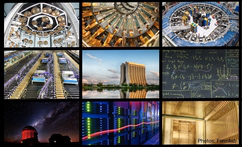The Short-Baseline Near Detector (SBND) will be one of three liquid Argon Time Projection Chamber (LArTPC) neutrino detectors positioned along the axis of the Booster Neutrino Beam (BNB) at Fermilab, as part of the Short-Baseline Neutrino (SBN) Program. The detector is currently in the construction phase and is anticipated to begin operation in the second half of 2022. SBND is characterised...
The Short Baseline Near Detector (SBND) is one of three detectors in the SBN program at Fermilab and will be using LArTPC technology to visualize neutrino interactions. The detector will have an active mass of ~112 tons of liquid argon and be stationed at ~110 m away from the Booster Neutrino Beam (BNB) target. The SBND experiment will investigate more into the low energy excess observed by...
The Short Baseline Near Detector (SBND) will be one of the three Liquid Argon Time Projection Chambers (LArTPCs) making up the Short Baseline Neutrino program (SBN) on Fermilab’s Booster Neutrino Beam (BNB). SBND will exploit its 112 ton active volume and its position just 110m along the BNB to observe upwards of 6 million neutrino argon interactions over a planned three year exposure. As a...
ICARUS is a Liquid Argon Time Projection Chamber, which is the Far Detector of the Short-Baseline Neutrino program. It uses the Booster beam and is located 103 mrad off-axis from the NuMI beamline at Fermilab. Prospects for cross-section measurements and progress with the selection of the electron neutrino from NuMI interactions will be shown. Accurate measurements of the neutrino...
Forty million times per second, the Large Hadron Collider (LHC) produces the highest energy collisions ever created in a laboratory. The Compact Muon Solenoid (CMS) experiment is located at one of four collision points on the LHC ring. Built like a cylindrical onion, CMS uses distinct layers of detectors to identify and measure outgoing particles. The resulting data can be used to study...
The CMS Phase-2 upgrade is intended to handle the increased data output and fluence expected in the high-luminosity operation of the LHC and requires developing and installing a redesigned silicon tracker. Silicon sensors close to the beam pipe will receive heavy radiation doses, leading to increased dark current and bias voltages that in turn generate increased heat load and put the detectors...
The observation and cross-section measurements of the WWW production using Run II data of the ATLAS detector with an integrated luminosity of 139 fb$^{-1}$ at $\sqrt{s}$ = 13 TeV are presented. Measurements are performed in two final states. In two leptons final state, WWW decays into two same-sign leptons associated with two jets are selected whereas, three leptons final state contains three...
Recently, machine learning applications, which have become extremely widespread in many fields of study, have enabled new work in the field of top quark physics. Deep learning models, which are biologically inspired algorithms that are rough simulations of the brain and contain interconnected nodes and layers, have particularly contributed to improved measurement techniques in recent years....
Over the course of recent runs, the KOTO Experiment has collected 1.8 million $K_L\rightarrow3\pi^0$ decay events yielding an incredible amount of virtually background-free $\pi^0$ decay data. This offers an opportunity to study $\pi^0$ decay to make a precision measurement of the $\pi^0$ Dalitz decay branching ratio. The E14 KOTO detector provides an excellent means of identifying $\pi^0$...
The SpinQuest (Fermilab E1039) experiment is a fixed target experiment with a transversely polarized $NH_3$ and $ND_3$ targets. Muon pairs from both Drell-Yan process and charmonium decay will be measured. The measurement of the azimuthal asymmetry can provide information on the Sivers function for the light sea quarks as well as the gluon. A non-zero Sivers function would evidence of orbital...
In the E1039/SpinQuest experiment at Fermi National Accelerator Laboratory, the Main Injector beam of 120 GeV protons will be incident upon a transversely polarized proton (NH$_3$) target, and we will observe $\mu^+\mu^-$ pairs from charmonium and Drell-Yan production. We expect that the $J/\psi$ and $\psi'$ will be produced by a mixture of $q\bar{q}$ and $gg$ interactions. Due to the high...
The SpinQuest experiment at Fermilab aims to perform the first Sivers function measurement on sea quarks to find evidence for non-zero orbital angular momentum of light antiquarks in the nucleon. In particular, the SpinQuest spectrometer will detect pairs of positive and negative muons from Drell-Yan production on polarized nucleons. In order to efficiently separate these events from the large...
The smallest and faintest galaxies around the Milky Way are the most ancient, most metal-poor, and most dark-matter-dominated systems known. These extreme objects offer unique access to small scales where the stellar and dark matter content can be studied simultaneously and hold the promise of major breakthroughs in understanding the nature of dark matter, and a more complete picture of galaxy...
